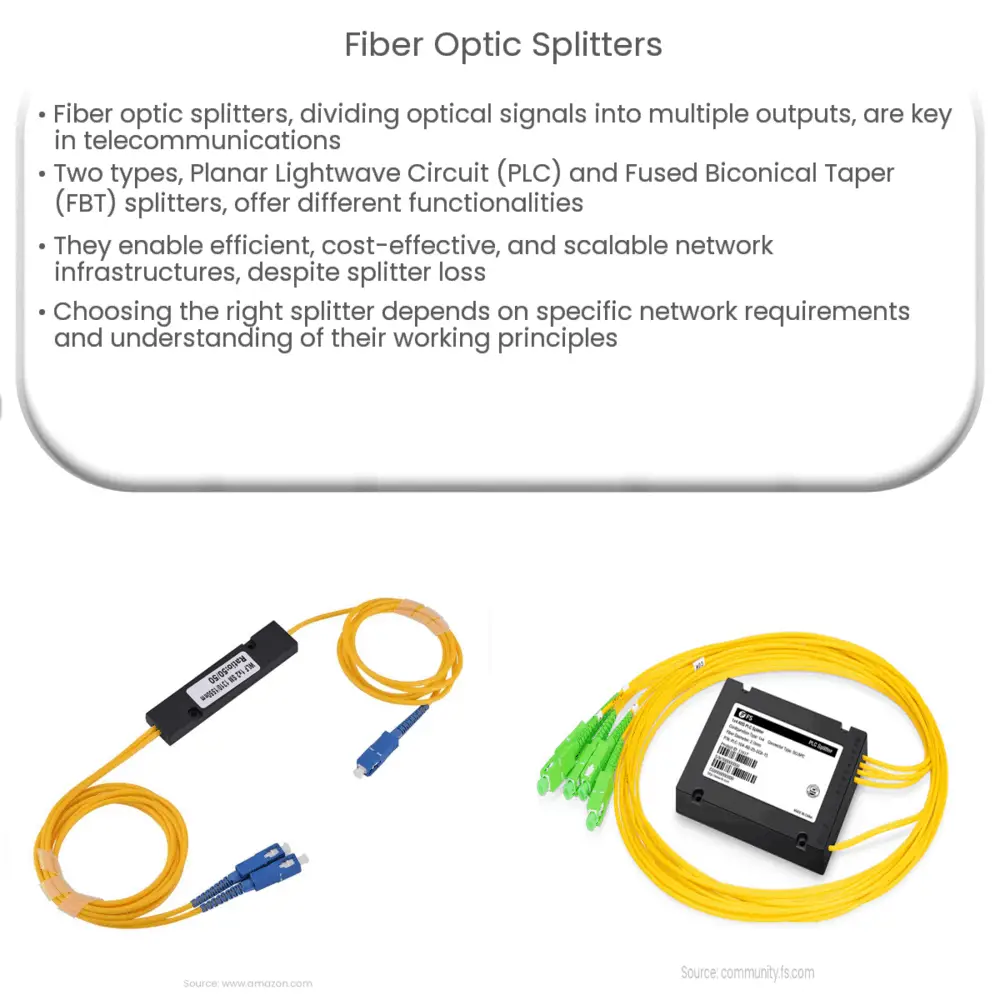Explore the role, types, and significance of fiber optic splitters in telecommunication networks, along with understanding splitter loss.

Understanding Fiber Optic Splitters
Fiber optic splitters, as the name implies, are devices that divide an optical signal into two or more outputs. They are integral components in the world of telecommunication and data networking, crucial to maintaining reliable and efficient communication infrastructures.
The Basics of Fiber Optic Splitters
There are two primary types of fiber optic splitters: the Planar Lightwave Circuit (PLC) splitter and the Fused Biconical Taper (FBT) splitter. PLC splitters, manufactured using a planar waveguide circuit and silica optical waveguide technology, are typically favored due to their ability to split light evenly across outputs. FBT splitters, on the other hand, are made by heating and fusing two fibers together, thus allowing light to split between the two fibers.
- PLC Splitters: These splitters are widely used due to their ability to work across a wide range of wavelengths with an equal distribution of light across all outputs.
- FBT Splitters: While not as popular as PLC splitters, FBT splitters are still in use, particularly in situations where splitting ratios are not equal.
The Importance of Fiber Optic Splitters
Fiber optic splitters have a host of applications in the telecommunication industry. They are critical to the functionality of networks like Fiber to the Home (FTTH), wherein a single optical fiber serves multiple homes or commercial buildings.
- Efficient Signal Distribution: The ability to split light signals into multiple outputs enables efficient use of a single optical fiber for serving multiple destinations. This efficiency is pivotal in maintaining robust and high-speed communication networks.
- Cost-effectiveness: Fiber optic splitters help to reduce the overall cost of network infrastructure by minimizing the number of required optical fibers.
- Scalability: With the use of fiber optic splitters, network expansion can be easily achieved without the need for additional fibers. This scalability is vital for the growth of telecommunication networks.
Fiber Optic Splitter Loss
Despite the advantages, it’s important to acknowledge the inherent loss associated with fiber optic splitters. The phenomenon, often referred to as splitter loss, is the reduction in power density (attenuation) that results from the splitting of the optical signal.
Splitter Loss: More Insight
The loss in an optical splitter is not a result of imperfection in the device but is a fundamental consequence of light division. When an optical signal is split, its total power is divided among the output fibers, resulting in a reduced signal strength. The extent of the loss depends on the number of output ports. For instance, a 1×2 splitter will have approximately 3dB of loss while a 1×4 splitter will result in about 6dB of loss.
Splitter Configurations
Optical splitters can be configured in various ways to suit specific networking requirements. Some of the common configurations include:
- 1xN Splitter: A single input fiber is split into N output fibers. It’s the most commonly used configuration for splitting signals to multiple destinations.
- NxN Splitter: Here, N input fibers are split into N output fibers. This type is typically used for more complex networks where multiple inputs need to be distributed to multiple outputs.
Choosing the Right Fiber Optic Splitter
Choosing the right fiber optic splitter depends on various factors, including the specific requirements of your network, the desired splitting ratio, and the allowable loss. Understanding the properties and the functionality of different types of splitters is crucial in making an informed choice.
Conclusion
As an essential component of optical networks, fiber optic splitters play a crucial role in enabling efficient, cost-effective, and scalable communication infrastructures. Their ability to split optical signals into multiple outputs allows a single optical fiber to serve multiple end-points. While inherent splitter loss is a consideration, the flexibility and the efficiency provided by these devices make them indispensable in the world of telecommunications. Whether it’s PLC or FBT, the choice of the splitter would depend on the specific use case and requirements of the network. With a clear understanding of their working principles, functionality, and the associated loss, one can make an informed choice, leading to a more robust and efficient communication network.

